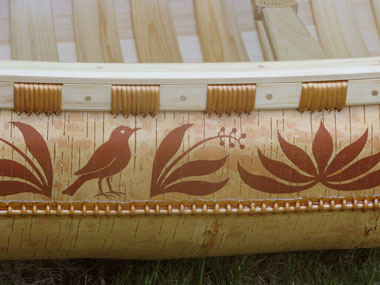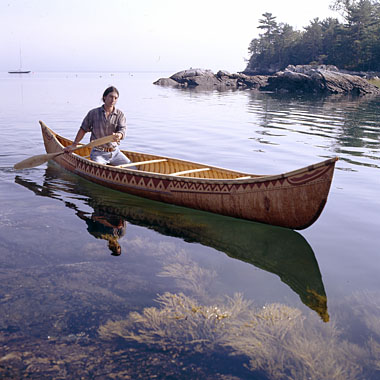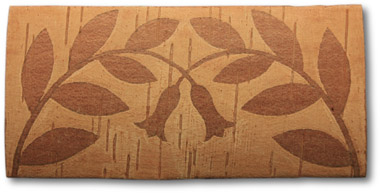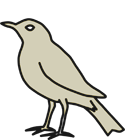My birchbark canoes are built in the traditional style of the Penobscot, Passamaquoddy, and Maliseet canoes of Maine and New Brunswick in the 1800s. During this time period a change took place in the typical style of the canoes of this area, which is most noticeable in the profile of the stems, or ends of the canoe. In the early 1800s the stems were raked outward so that the canoe’s point of greatest length was at the top of the stems. Later in that century, and into the next, the stems most often took on a more curved profile.
 Side panel detail of 14-foot canoe
Side panel detail of 14-foot canoeMost of my canoes are built in the old style, with gracefully raking stems. All of them are fastened with rock maple pegs, and lashings made from the boiled, peeled and split roots of red spruce. There are no metal fastenings in them. My canoes have sharp, fast lines, as do the old birchbark canoes of Maine and New Brunswick. They have a gentle rise of the sheer or gunwale line, and a high tumblehome or inward curve of the sides. The ribs are relatively wide, for a very strong hull, and the planking is fitted edge-to-edge, which gives a neat appearance inside the canoe. The handling of these canoes is superb; they are stable, yet quick and responsive under paddle.
 18-foot canoe built by Steve in 1999, paddled by David Moses Bridges on Frenchmans Bay
18-foot canoe built by Steve in 1999, paddled by David Moses Bridges on Frenchmans BayOne noteworthy feature of my canoes is the use of double headboards. Headboards are the oval boards or bulkheads that close off and brace the ends of the hull beyond the last ribs. In most Wabanaki canoes these are curved outward and sprung into position under the ends of the inwales, or inner gunwales. The shoulders of the headboards help carry the gunwales, and this combined with their bent shape earned them the name wunigesu in Penobscot, which means “portager.” The space beyond the headboards is typically stuffed with cedar shavings on many old canoes, to help the ends keep their shape. This method is simple and effective, but it has the disadvantage of trapping moisture it the shavings ever get wet.
An alternative method that was developed by some Passamaquoddy builders in the late 1800s is to use a second, smaller headboard between the main headboard and the stem, in place of the shavings. This second headboard serves the same purpose as the shavings, but far better, and it cannot trap moisture. I have been using double headboards in all my canoes since 2001.

I build birchbark canoes from 14 to 20 or more feet long, with the actual length overall finishing about 1-3 inches over the nominal length. The most popular sizes are 16 feet, weighing from 50 to 60 pounds, and 18 feet, weighing from 65 to 75 pounds. The range of weights is due to the variability of materials, especially the bark, which varies in color and width as well. Differences in bark width are made up by the addition of side panels, using traditional arrangements and spruce root stitching, but the length of the bottom is made of a single sheet.





